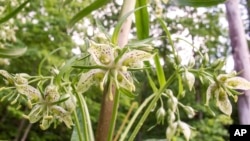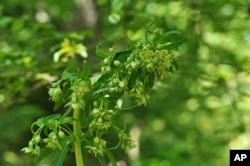Some plants, known as flowering annuals, bloom without stop before dying at the end of the year or season.
Other flowering plants, known as perennials, return every year. They can bloom all season, with a lot of blossoms at first followed by additional flowers from time to time. Sometimes it is a limited show that can last as little as two weeks.
Biennials flower only in their second year before dying.
Monocarpic plants
But there is another group of plants called monocarpics. Their name comes from the Greek words for “single,” mono, and “fruit,” carpos. Monocarpics spend their whole lives growing in size only to produce a single bloom before dying.
Some monocarpic plants have a following among a small group of gardeners. These gardeners enjoy what can be years of waiting. They often throw parties to show their plant’s once-in-a-lifetime bloom to others.
Other growers, however, can be surprised to discover their 30-year-old plant unexpectedly blooming, only to watch it die immediately afterward.
Flowers have a purpose: to ensure the continuation of their species. After their bloom ends, plants produce seeds that grow into new plants.
Monocarpic plants have just one chance at this. So, as you might imagine, the effort is often spectacular.
Examples of monocarpics
Take the century plant. Rather than living for 100 years, as its name suggests, it has an average lifespan of just 10 to 30 years. It is a desert plant native to Mexico and Texas.
During its life, it grows to 1.8 meters tall before sending up a giant flower stalk that can reach nine meters, often surprising its owners.
A 19-year-old American columbo plant growing at the North Carolina Botanical Garden in Chapel Hill bloomed this spring. The plants are native to the eastern and central United States. They grow quickly for many years before pushing forth flowers that are up to two meters long.
The monocarpic plant group also includes the fishtail palm. It can grow over 15 meters in height. The trees produce flowers with yellow centers when they are between 10 and 20 years old.
The good news is the show of flowers can last up to 5 years, after which only the blooming trunk will die, leaving secondary trunks, if present, to take over. However, fishtail palms grown as houseplants are not likely to bloom.
Bamboo is also a monocarpic plant. But it can take more than 100 years for some bamboo species to flower, and even then, sometimes their roots push up new plants.
Bananas, too, are monocarpic, but they reproduce by sending up suckers, or small, new plants, from their roots. After their one-and-only fruit crop is harvested, the main plant is cut to ground level, leaving the suckers to take over.
I’m John Russell.
Jessica Damiano reported on this story for the Associated Press. John Russell adapted it for VOA Learning English.
______________________________________________
Words in This Story
bloom – v. to produce or yield flowers —n. a flower
blossom —n. a flower —v. to produce flowers
gardener –n. a person who raises and keeps plants for flowers and for food
spectacular – adj. describes the quality of being unusual, notable, or entertaining
trunk -- n. the main part of a tree apart from limbs and roots
species – n. a category of biological classification ranking immediately below the genus or subgenus













Forum